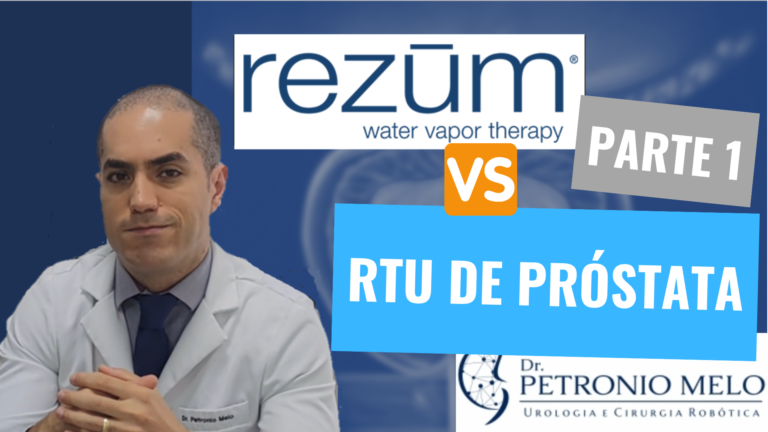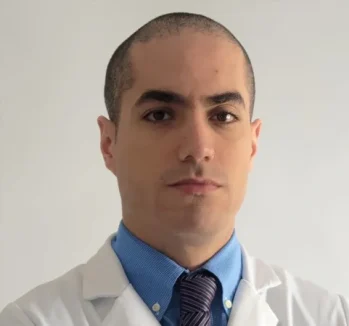Index
Rezum vs. Prostate RTU – Part 1: In this initial article on the topic, we will discuss and compare the function, benefits, and risks of each treatment method for benign prostatic hyperplasia (BPH).
How does the Rezum treatment work?
Rezum is a relatively new technique for treating BPH, also known as prostate enlargement. The procedure was FDA-approved in 2015 and has been gaining popularity since. But how exactly does the Rezum treatment work? Let’s find out:
How is water energy used in the Rezum procedure?
During the Rezum procedure, a device called an energy generator is inserted into the patient’s urethra and positioned near the prostate. The energy generator uses water energy to produce therapeutic steam, which is then applied directly to the areas of the prostate causing urinary flow problems.
Steam is injected into the prostate using a special needle, which is inserted through the energy generator. The steam’s temperature is high enough to destroy the enlarged prostate tissue, but low enough to avoid harming healthy tissues near the prostate.
What are the benefits of using water energy in the Rezum treatment?
Using water energy in the Rezum treatment offers several advantages. Compared to other treatments for BPH, Rezum is less invasive and quicker to perform. The procedure is typically done in a medical office and can be done under local anesthesia.
Another benefit of the Rezum treatment is that it doesn’t require the removal of prostate tissue. Unlike prostate TURP, which involves removing enlarged prostate tissue by scraping, Rezum destroys prostate tissue using therapeutic steam.
What are the possible side effects of the Rezum treatment?
Rezum treatment side effects are generally mild and short-lived. Some patients may feel a heightened urgency to urinate right after the procedure, but this usually subsides within a few weeks. It’s also common to experience some pain or discomfort during urination in the first few weeks after the procedure.
Who is a good candidate for the Rezum treatment?
Rezum treatment might be a good option for men with mild to moderate BPH symptoms that haven’t been relieved with medications. It’s important to discuss treatment options with your doctor to determine if Rezum is the right choice for you.
How does Rezum treatment compare to other BPH treatment options?
Rezum treatment has been compared to other BPH treatment options, such as TURP and green light laser therapy. Studies have shown that Rezum offers results similar to TURP and green light laser therapy, but with fewer side effects and a quicker recovery time. Green light laser therapy might take longer to relieve BPH symptoms but can be a good option for patients with larger prostates. TURP is still widely used and might be more suitable for patients with very large prostates or more severe BPH problems.
It’s important to discuss your treatment options with your doctor to determine which option is best for you. If you are considering Rezum treatment, make sure to discuss the possible pros and cons of the treatment with your doctor and ask about their experience with the procedure. With the right guidance, you can make an informed decision about which treatment is best for you and your condition.
How does Transurethral Resection of the Prostate (TURP) work?
The Transurethral Resection of the Prostate (TURP) is a common procedure for treating benign prostatic hyperplasia (BPH), also known as prostate enlargement. It’s a minimally invasive technique involving the removal of enlarged prostate tissue by scraping. Here’s a more detailed explanation of how TURP works:
What is TURP?
The Transurethral Resection of the Prostate (TURP) is a minimally invasive surgical procedure used to remove enlarged prostate tissue causing urinary flow issues. During the procedure, an instrument called a resectoscope is inserted into the patient’s urethra and advanced to the prostate.
How is TURP performed?
The resectoscope contains an electric cutting blade used to remove the enlarged prostate tissue by scraping. The doctor guides the resectoscope through the prostate, removing small pieces of tissue as they proceed.
During the procedure, the doctor may also use an irrigation fluid to clear the operating field and help improve visibility. The irrigation fluid is absorbed into the bloodstream and is excreted by the kidneys.
What are the benefits of TURP?
TURP is a highly effective procedure for relieving BPH symptoms and improving urinary flow. It’s a minimally invasive technique usually done in a medical office and doesn’t require prolonged hospitalization. Patients typically can return to their regular activities within a few weeks after the procedure.
What are the possible side effects of TURP?
TURP is generally considered safe, but there are some risks associated with the procedure. Common side effects include bleeding, pain, and difficulty urinating. Some patients may experience ejaculation issues or impotence following the procedure. There’s also a risk of infection or damage to the urethra.
Who is a good candidate for TURP?
TURP is a suitable option for patients with severe BPH symptoms that haven’t been alleviated with medications. It’s essential to discuss treatment options with your doctor to determine if TURP is the right choice for you.
How does TURP compare to the Rezum treatment?
Compared to the Rezum treatment, TURP is a more invasive procedure involving the removal of enlarged prostate tissue by scraping. While TURP is highly effective, it might come with a longer recovery time and a higher risk of side effects. Some patients may also experience long-term complications, such as ejaculation problems or impotence. However, TURP is still widely used and may be more suitable for patients with very large prostates or more severe BPH issues.
It’s crucial to discuss your treatment options with your doctor to determine which choice is best for you. If you’re considering TURP, ensure you discuss the potential pros and cons of the treatment with your doctor and inquire about their experience with the procedure. With the right guidance, you can make an informed decision about the best treatment for you and your condition.
What are the benefits of the Rezum treatment?
The Rezum treatment is a relatively new technique for treating benign prostatic hyperplasia (BPH), also known as prostate enlargement. The procedure was approved by the FDA in 2015 and has been gaining popularity ever since. But what are the benefits of the Rezum treatment compared to other BPH treatment options? Here are some of the advantages of the Rezum treatment:
The Rezum treatment is less invasive than other treatment options
One of the main benefits of the Rezum treatment is that it’s less invasive than other BPH treatments, like TURP. The procedure is generally performed in a medical office and can be done under local anesthesia. This means the recovery time is quicker, and the patient can return to their normal activities more swiftly.
The Rezum treatment doesn’t involve removal of prostate tissue
Unlike TURP, which involves removing enlarged prostate tissue by scraping, the Rezum treatment destroys prostate tissue using therapeutic steam. This means the Rezum treatment doesn’t require tissue removal, which can be beneficial for patients wanting to avoid more invasive procedures.
The Rezum treatment offers long-lasting results
The Rezum treatment provides enduring results and significantly improves BPH symptoms. Studies have shown that the Rezum treatment can improve urinary flow and alleviate other BPH symptoms for up to two years or more. This means patients undergoing the Rezum treatment can enjoy prolonged relief from BPH symptoms.
The Rezum treatment has fewer side effects than other treatment options
The Rezum treatment is generally considered safe and has fewer side effects than other BPH treatments. Common side effects include increased urgency to urinate and some pain or discomfort during urination in the first few weeks after the procedure. These side effects typically vanish within a few weeks.
The Rezum treatment can be a good option for patients with underlying medical conditions
The Rezum treatment might be suitable for patients with underlying medical conditions that make other treatment options less safe. For example, patients with blood clotting issues might not be good candidates for TURP, but they might still be eligible for the Rezum treatment.
The Rezum treatment may be less painful than other treatment options
The Rezum treatment is generally less painful than other BPH treatments, such as TURP. The procedure is usually well-tolerated by patients, and many report feeling little to no discomfort during or after the procedure.
What are the limitations of the Rezum treatment?
While the Rezum treatment has many benefits compared to other BPH treatments, there are also some limitations to consider. For instance, the Rezum treatment might not be suitable for patients with very large prostates. Moreover, the treatment might take longer to relieve BPH symptoms compared to other treatment options, such as green light laser therapy.
What are the benefits of TURP?
Transurethral resection of the prostate (TURP) is a common treatment for benign prostatic hyperplasia (BPH), also known as prostate enlargement. Although TURP is an invasive procedure, it also offers several benefits to patients experiencing BPH symptoms. Here are some of the advantages of TURP:
TURP is Highly Effective
TURP is a highly effective treatment for alleviating BPH symptoms. During the procedure, the enlarged prostatic tissue is removed by scraping, significantly improving urinary flow and relieving other BPH symptoms. In some cases, TURP can be as effective as radical prostatectomy in improving BPH symptoms.
TURP is a Minimally Invasive Procedure
Although TURP is a surgical procedure, it is considered minimally invasive compared to other BPH treatment options. The procedure is typically performed in a medical office under general or local anesthesia, and patients can return to their regular activities within a few weeks following the procedure.
TURP is Relatively Safe
TURP is generally considered safe, with a relatively low complication rate. The most common side effects include bleeding, pain, and difficulty urinating post-procedure, but these side effects usually subside within a few weeks. TURP also has a low rate of severe complications, such as infections or injuries to the bladder or urethra.
TURP can be Performed on Patients with Very Large Prostates
TURP can be performed on patients with very large prostates, making it an effective treatment option for patients with severe BPH symptoms. Although other treatments, like green laser therapy, may be more suitable for larger prostates, TURP can still be a good option for patients with large prostates.
TURP Offers Long-Lasting Results
TURP provides lasting results and significantly improves BPH symptoms. Studies have shown that most patients experience significant improvement in BPH symptoms following TURP, and many patients experience symptom relief for many years post-procedure.
What are the limitations of TURP?
Although TURP offers many benefits, there are also some limitations to consider. TURP might be associated with a higher complication rate in patients with blood clotting issues or other health problems that can affect the safety of the procedure. Moreover, TURP can be more invasive than other BPH treatment options, which can impact the patient’s recovery.
Side Effects and Risks Associated with the Rezum Treatment
The Rezum treatment is generally considered safe and effective for treating benign prostatic hyperplasia (BPH). However, as with any medical procedure, there are risks associated with the treatment. Here are some potential side effects and risks associated with the Rezum treatment:
Bleeding
One of the most common side effects of the Rezum treatment is bleeding in the urine or semen. This is normal after the procedure and should subside within a few days. However, in rare cases, the bleeding might be more severe, requiring medical attention.
Pain
Some patients report pain or discomfort after the Rezum treatment, especially during urination or ejaculation. This is typical and should diminish within a few days or weeks post-procedure. Patients might also receive medication to alleviate pain and discomfort.
Infection
Though rare, infection is a potential risk associated with the Rezum treatment. Patients are monitored for signs of infection like fever, pain, or swelling, and are prescribed antibiotics to help prevent infection post-procedure.
Urinary Difficulty
Some patients might experience difficulty urinating after the Rezum treatment. This typically happens because the prostate tissue treated by the procedure swells and might take a few weeks to reduce. Patients might also require a catheter for a few days post-procedure to help drain urine.
Urinary Incontinence
Although rare, urinary incontinence is a potential risk with the Rezum treatment. This might happen if the treated prostate tissue affects bladder function. Patients are monitored for signs of incontinence and might need further treatment if symptoms appear.
Who is at a higher risk of severe side effects from the Rezum treatment?
While the Rezum treatment is generally considered safe, there are factors that might increase the risk of severe side effects. Patients with especially large prostates might be at a higher risk of complications, as might those with a history of urinary tract infections. Patients might also be at increased risk if they have blood clotting issues or other medical conditions affecting prostate health.
Rezum vs. TURP: A comparison in terms of risks and side effects
Compared to TURP, the Rezum treatment is considered less invasive and has fewer associated side effects and risks. However, TURP is a more established procedure with proven efficacy in patients with larger prostates or more severe BPH symptoms. It’s essential to discuss treatment options with your doctor to determine the best choice for you and your condition.
In summary, the Rezum treatment is generally regarded as safe and effective for BPH treatment, but there are risks associated, such as bleeding, pain, and infection. However, these side effects are typically temporary and fade within a few weeks post-procedure. Compared to TURP, the Rezum treatment is less invasive and has fewer side effects and risks, but might not be as effective in patients with larger prostates or more severe BPH symptoms. It’s essential to discuss treatment options with your doctor to determine the best choice for you and your condition.
Side Effects and Risks Associated with TURP
Transurethral resection of the prostate (TURP) is a common surgical procedure used to treat benign prostatic hyperplasia (BPH). As with any medical procedure, there are risks and side effects associated with TURP. Here are some potential side effects and risks linked to TURP:
Bleeding
Bleeding is a common side effect of TURP. Patients might experience bleeding in the urine or semen for a few days following the procedure. In rare cases, the bleeding might be more severe and require medical attention.
Infection
Infection is another potential risk associated with TURP. Patients are prescribed antibiotics post-procedure to help prevent infection; however, it’s still possible that it may occur. Patients are monitored for signs of infection, such as fever, pain, or swelling.
Urinary Incontinence
Urinary incontinence is a rare, but potentially serious, side effect of TURP. This can occur if the sphincter muscle, which controls the release of urine from the bladder, is damaged during the procedure. Patients are monitored for signs of incontinence and might need further treatment if symptoms appear.
Erectile Dysfunction
Although rare, erectile dysfunction is a potential side effect linked to TURP. This can happen if the nerves controlling erection are damaged during the procedure. Patients are monitored for signs of erectile dysfunction and might require additional treatment if symptoms emerge.
Ejaculation Issues
TURP can affect ejaculation, leading to a decrease in semen volume or difficulty ejaculating. This is usually temporary and should improve within a few weeks post-procedure.
Acute Urinary Retention
In rare instances, TURP can cause acute urinary retention, meaning the patient is unable to urinate. This can be treated with a temporary catheter but poses a serious health risk to the patient.
Who is at a higher risk of severe side effects from TURP?
Patients with especially large prostates might be at an increased risk of complications during TURP. Moreover, those with a history of urinary tract infections or blood clotting issues might also be at a higher risk of complications. It’s essential to discuss treatment options with your doctor to determine the best choice for your specific condition.




